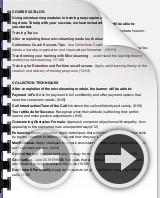COURSE CATALOG
COURSE CATALOG
Using microlearning modules in training may require a shift in how we get train- ing done. To help with your success, we have included several modules to get you started.
Training Topics
After completing these microlearning modules, the learner will be able to:
Collections Coach Success Tips: Use Collections Coach microlearning modules to create a learning organization and improved performance. (16:01)
Transforming your training with Microlearning: understand the learning theory underlying microlearning. (17:48)
Training for Retention and Performance Success: Apply adult learning theory to the creation and delivery of training programs. (13:03)
COLLECTION TECHNIQUES
After completion of the microlearning module, the learner will be able to:
Payment in Full: Ask for payment in full confidently, and offer payment options that meet the consumers needs. (6:09)
Call Introduction/Tone of the Call: Introduce the call confidently and calmly. (5:56) Your attitude for Success: Recognize when their attitude is affecting their performance and make positive adjustments. (8:16)
Overcoming Obstacles Formula: Approach consumer objections with empathy, thus appealing to the consumer in an unexpected way.(4:12)
Enhancing Communication: Apply techniques that will enhance communication skills by paying attention to what they say and how they say it. (7:16)
MacNCheese: Apply strategies to ensure consistent procedures and practices to sup- port improved success. (4:04)
Control the call: Apply at least one strategy for regaining control of a call. (3:36)
Goal setting…and ACHIEVING!: Set goals that are compatible with company goals
and create a strategy to achieve the goals.(10:56)
Don’t take it Personally: Apply techniques to let go of emotions caused by difficult calls. (2.46)
Page 1
COURSE CATALOG
COLLECTION TECHNIQUES
After completion of the microlearning module, the learner will be able to:
The Empathy Connection: Describe 3 types of empathy and demonstrate how em- pathy creates a positive result in collection calls. 8:08
FLO: Improve the first impression they make on consumers. (2:04)
Stress Management: Describe the different kinds of stress and describe several behaviors that can help relieve stress. 6:50
Hygiene: Describe a heightened awareness of the impact their personal hygiene has on coworkers. (3:42)
Call De–escalation: Provide calming responses to consumers that will aid in de– escalation of emotional calls. (9:03)
Time Bandits: Recognize activities that steal their productive time and apply strate- gies to solve the problem. (9:36)
Power Words—You: After completing this lesson, the learner will be able to frame re- sponses to the consumer using the power word You. (6:40)
Additional topics are under construction!
COMPLIANCE
Parent of an Adult: Respond to the parent of an adult consumer within the requirements of the FDCPA. (1:43)
Handling Verbal Disputes: Use the APE approach (Acknowledge, Probe, Explain) to seek dispute resolution.(10:29)
Consumer with an attorney: properly handle calls in which consumers inform the collector of attorney representation. (2:56)
Preserving Account Integrity: Maintain account integrity to ensure better right party contacts and prevent misrepresentation and harassment. (8:29)
Handling Bait Calls: Recognize callers who are attempting to bait the learner into vi- olating the law, and apply strategies for handling such calls. (22:59)
Overshadowing: Honor the validation period and the consumer’s rights that exist within it. (10:20)
Avoid Inconvenience: Define inconvenient times and places at which to call con- sumers to collect a debt and avoid calling consumers at such times and places. (4:23)
Page 2
Skiptracing: Avoid revealing that the consumer owes a debt while seeking location information about a consumer. (7:54)
Avoid Misrepresentation: Define misrepresentation and avoid behaviors that are pro- hibited by the FDCPA. (12:53)
Attorney Representation: Communicate only with the consumer’s attorney regarding a debt after you are notified of representation. (7:42)
Avoid Threats to Harass: Define harassment and avoid behaviors that may result in allegations of harassment or threats of harassment. (6:12)
Avoiding Unprofessional Communication: Adjust your communication when you know how way your words, communication approach and environment affect con- sumers. (5:13)
Cease Communication Requests: Recognize demands or requests to cease commu- nication and respond to them in compliance with the FDCPA (6:38)
Call Baiting: Recognize specific consumer attempts to lead you to violate the law, and respond appropriately. (8:50)
Creating Positive Perceptions: create a positive consumer experience to increase satisfaction and prevent complaints (7:12)
Communicating with Third Parties: Maximize potential by seeking permission to speak with third parties, and minimize risk by handling unauthorized third parties properly. (6:46)
Identify the Company: Identify the company properly to consumers to avoid allega- tions of misrepresentation. (3:07)
Identify the Consumer: Define who is a consumer under the FDCPA, and who is a third party, and avoiding third party disclosure. (6:06)
Required Verbal Disclosures: Identify the proper time to provide the Mini–Miranda disclosure, call recording disclosure, and out of statute debt disclosures, and use the practice tips to provide them in compliance with the FDCPA. (7:03)
Additional topics are under construction!
Page 3

We are working on a Supervisory training series which will include the following topics:
- Developing a Managerial Approach
- Weaving Four Irreplaceable Fundamentals into your Style
Coaching for Performance:
- Define coaching in performance –based terms and verbalize how effective coaching can increase employee performance.
- Compare and contrast the traditional management style and the coaching man- agement style, and describe the benefits that coaching provides managers.
- Utilize the four states of the GROW coaching sequence to plan and conduct an effective coaching session
- Formulate appropriate questions for each state of a formal coaching session in accordance with the GROW coaching sequence
- Convert the coaching discussion into a decision by the employe that will trans- late into a specific action plan to be followed.
- Verbalize the relationship between optimizing performance, developing potential, and coaching.
- Describe the learning cycle and describe how coaching can increase effective- ness of the stages of the learning cycle.
- Verbalize the importance of motivation and empowering people through the use of coaching.
- Describe Maslow’s Hierarchy of Needs and its relationship to effective coaching.
- Identify the five commonly used levels of feedback and describe which levels are more appropriate for use in coaching, and why.
- Utilize the coaching method and tools to plan and conduct an effective coaching session.
Page 4
